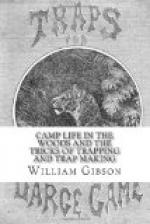The puma loves to hide in the branches of trees, and from this eminence to launch itself upon the doomed animal that may pass within its reach. It may, therefore, be easily imagined how treacherous a foe the creature may be when ranging at will among the countless trees and jungles of our American forests.
Although so stealthy and sly a creature the cougar possesses very little cunning and is easily trapped. The Gun trap, page 20, is commonly and successfully employed in South America in the capture of the jaguar, as our title illustration, page 15, represents, and it may also be used with the same success in trapping the puma. The Bow trap, page 23, and the dead-fall described in the early part of the book, will all be found to work admirably in the destruction of this treacherous beast.
The animal may be entrapped alive, should any of our young trappers dare to try the experiment.
There are two ways of accomplishing this. The first is by the aid of a huge coop of logs, as described on page 30 or 33, and the other by the Pit-fall, as exemplified on page 31. Huge twitch-ups may also be constructed, using very strong wire. The bait may consist of a fowl, sheep’s head, or the heart of any animal. Fresh meat of any kind will answer the purpose, and in the case of the Pit-fall a live fowl is preferable to a dead one as it will attract the puma by its motions, or by its cackling, and thus induce him to spring upon his prey, which will precipitate him to the bottom of the pit and thus effect his capture.
They are commonly taken with the steel trap. The puma seldom leaves the vicinity of the carcass of an animal it has killed until it is all devoured. When such a carcass can be found the capture of the beast is easily effected. Set the trap, size No. 5, page 143, near the remains, and cover the carcass with leaves. The next visit of the animal will find him more attached to the place than ever,—so much so that he will be unable to “tear himself away.”
[Page 164] The skin of the puma is properly removed by first cutting up the belly as described under the Beaver, using great care about the head and face. Use the hoop stretcher, page 275.
THE CANADIAN LYNX.
The lynx represents another of the Cat tribe, and as its name implies is a native of the regions north of the United States, although sometimes found in upper Maine and on the lower borders of the great lakes. It is commonly known throughout Canada as the Peshoo, or “Le Chat.”
Our illustration is a truthful representation of the animal. Its total length exceeds three feet, and its tail is a mere stub. The fur is thick, and the hairs are long, the general color being grey, sprinkled with black. The legs are generally darker than the body, and the ears are often edged with white. The limbs and muscles are very powerful, the paws are very large for the size of the animal, and are furnished with strong white claws, which are imbedded in the fur of the feet when not in use, they are shown in our illustration. The ears of the lynx form a distinct feature, by which the animal could be easily identified; they are long and tipped with stiff projecting hairs, giving the creature a very odd appearance.




